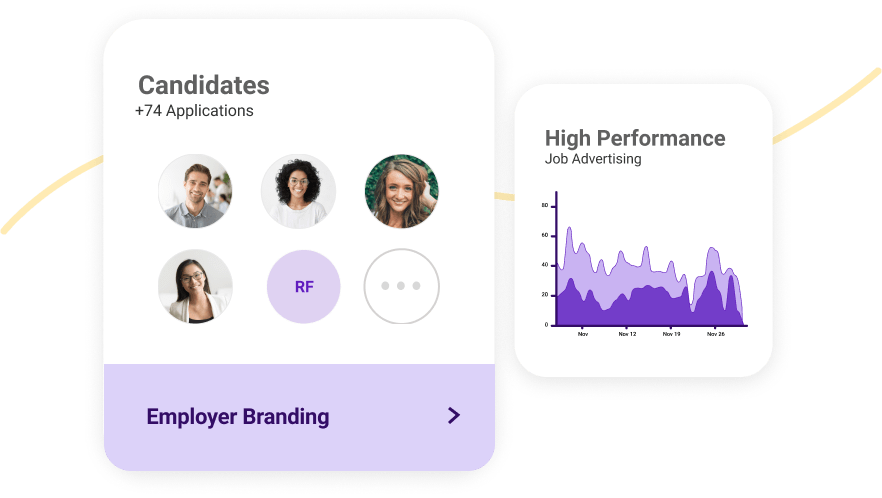How to Craft a High-Volume Recruitment Budget
Creating and managing a recruiting budget is almost no one’s favorite part of the job. Yet, it’s essential to success, not just of your recruiting efforts, but of the company.
Budgeting takes a lot of time to get right, involves getting managerial approval, and sets the tone for your year of hiring. Crafting one takes time, so we’re here to help you through the process.
A recruiting budget is an annual estimate of the total cost of recruiting for your company. It considers both fixed and variable costs and should factor in even unplanned expenses.
Some of the many expenses you will have to consider are:
- Advertising
- Agency costs
- Recruiting software
- Outsourcing
Make your high-volume recruitment budget work for you with our step-by-step guide.
Creating a High-Volume Recruitment Budget

Before you start building out your budget, you should first assess the current state of recruiting at your organization.
Make a budget plan
When planning for a new fiscal year, ask yourself a few key questions:
How important is recruiting to the overall success of your company?
If recruiting is historically a low priority, it can be difficult to gain valuable executive buy-in. You will need to work smarter to justify your budgeting needs.
How successful has your recruiting strategy been in the past few years?
A high budget doesn’t necessarily mean a high level of success, but the two often go hand in hand. Knowing how much you invested for the number of candidates you received in years past will be helpful as a benchmark. Compare your total investment, total hires, and cost per hire for the last 2-3 years to know the benchmark metrics.
Do you notice any trends starting to form for how hiring works for you and your team?
If your cost per hire has increased significantly over the past few years, it may be due to any number of factors. A new competitor entering your space, a decrease in the skilled talent you’re looking for, changes in the industry, etc. Despite the cause, it’s good to identify changes that affect your talent pool so you can be prepared to address them in your budget.
With an understanding of past years and a knowledge of current trends affecting your industry, you can create realistic hiring goals for the new year with a budget to match.
Determine volume of applicants needed
A budget begins with the number of people you need. For high-volume recruiting, lots of hires are needed to get fully staffed. Break this down by quarter and by position. Some positions are harder to fill than others, and some industries need more help seasonally. Take note of any company- or industry-specific factors that will affect your hiring in each quarter.
Don’t forget to factor in your turnover rate here. If you are expecting 10% of your employees for a certain role to leave the company within the next year, you’ll need to account for those leaving by fulfilling your annual needs and make up for your losses.
Projected annual headcount is hugely important as the rest of your budget will be geared toward targeting, attracting, and hiring these candidates.
Classify expenses into fixed vs. variable costs

The next step of budget prep comes in classifying your costs.
Fixed recruiting costs are those that are recurring expenses. You pay them yearly and they don’t really change once you set them. Variable costs, on the other hand, are those that can shift throughout the year based on internal or external factors.
Some examples of fixed recruiting costs are:
- Salaries for yourself and your team
- Partner and external agency costs
- Technology expenses
- Staff tools (subscriptions, trainings, etc.)
A few examples of variable recruiting costs would be:
Putting your costs into these categories will make calculating your total recruiting costs easier.
Calculate cost per hire
Finally, it’s time to put your costs together and calculate your budget. You’ll want to list your essential recruiting costs, both fixed and variable, for the year. Add these numbers together to get your target recruitment budget.
From there, you can calculate the most important recruiting KPI: cost per hire. To get this metric, take your total recruiting cost (the budget you just created, of internal plus external costs) and divide it by your expected number of hires.
Of course, the work doesn’t stop there. It takes constant monitoring of your budget to stick to it. Improvements can be made throughout the year – such as decreased spending on a channel that has a low sourcing channel effectiveness – that will help your cost per hire remain adaptable to changing circumstances.
Year to year, you should aim for your recruiting budget to get more ROI. That doesn’t necessarily mean a smaller budget – but one that is spent smarter.
Let’s walk through the major expense categories to compile your budget.
Calculating Recruitment Expenses

After estimating the number of hires you need and before calculating your cost per hire, you’ll need to understand your recruiting expenses across all categories.
These are some of the basic costs involved in the high-volume recruitment process.
Software costs
Recruiting technology is essential to modern-day hiring. There are many different tools you can use to assist and automate your hiring process:
- Applicant tracking systems (ATS)
- Video interviewing software
- Background check services
- Assessment software
Sum up the yearly cost you pay for these tools to add them to your budget.
Software costs money every year, but the time and resources you save typically make the services well worth the cost.
Advertising costs
This includes the cost of posting on job boards, paid search engine marketing, and any expense associated with posting or promoting a position. Add up the cost of each job posting you made on a platform, or the annual amount paid for recruiting accounts, to get this number.
On average, job advertising can take up as much as a third of your recruitment budget.
Agency costs
If you get any recruiting help from outside the organization, one major fixed cost you’ll need to worry about paying for is any external agency fees.
Each recruiting or staffing agency has its own cost breakdown, but typically they float around 20% of the base salary for the role they’re helping you fill. Consider the approximate number of hires you’re planning to make. Then, factor in the external agency cost associated with each hire.
Outsourcing
Some companies prefer to outsource most or all their high-volume recruiting.
A recruitment process outsourcing (RPO) company assesses your hiring needs and makes recommendations based on them. RPOs typically have their own preferences when it comes to best job advertising services, software, etc., so this can be a safe way to go if you’re new to the space or in need of expert recommendations.
You can also outsource individual roles, and typically you do so with a staffing agency.
A note on tax deductions
Many common recruiting expenses are tax deductible. For example:
- Recruitment advertising
- Office supplies
- Career fair costs
- Website expenses
- Certifications
Talk to a certified accountant or tax professional to make sure you’re not paying some expenses without getting the tax benefits that come with them.
High-Volume Budget Strategies

Once you establish your budget, you’ll need to manage it effectively throughout the year. Here are some top strategies for doing so.
Budgeting strategies
- Set KPIs and stick to them.
- Use a budget tracking platform (or your ATS) to follow along with your budget throughout the year and make sure you’re not getting off track.
- Your budget is fluid – don’t set it and forget it. When checking in, make updates where it makes sense.
- Use analytics to identify sources or costs that are a waste of time and money.
- Review your budget at the end of the year for positives, negatives, and cost per hire.
Getting leadership on board
It can be difficult to get leadership on board with your proposed recruiting budget. To get buy-in for your budget, show exactly where your money is going and highlight successes when they come. Explain that, like marketing activities, many costs associated with high-volume recruiting are necessary even when their results cannot directly be seen.
How to Create a Cost-Effective Recruiting Strategy
By following these steps and guidelines – especially the groundwork at the beginning and the monitoring throughout – your high-volume recruitment budget is sure to be realistic and strong.
Maintain a cost-effective recruiting strategy by encouraging employee referrals, using automation where you can, and incorporating the top technology in the game.
Taking this methodical approach to budgeting will allow you to meet your hiring goals without paying a fortune.
See more of our high-volume recruiting guide →



